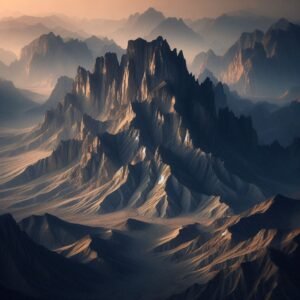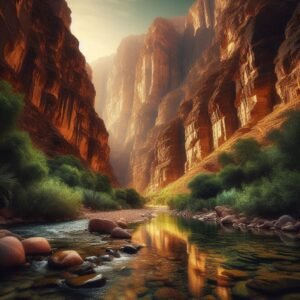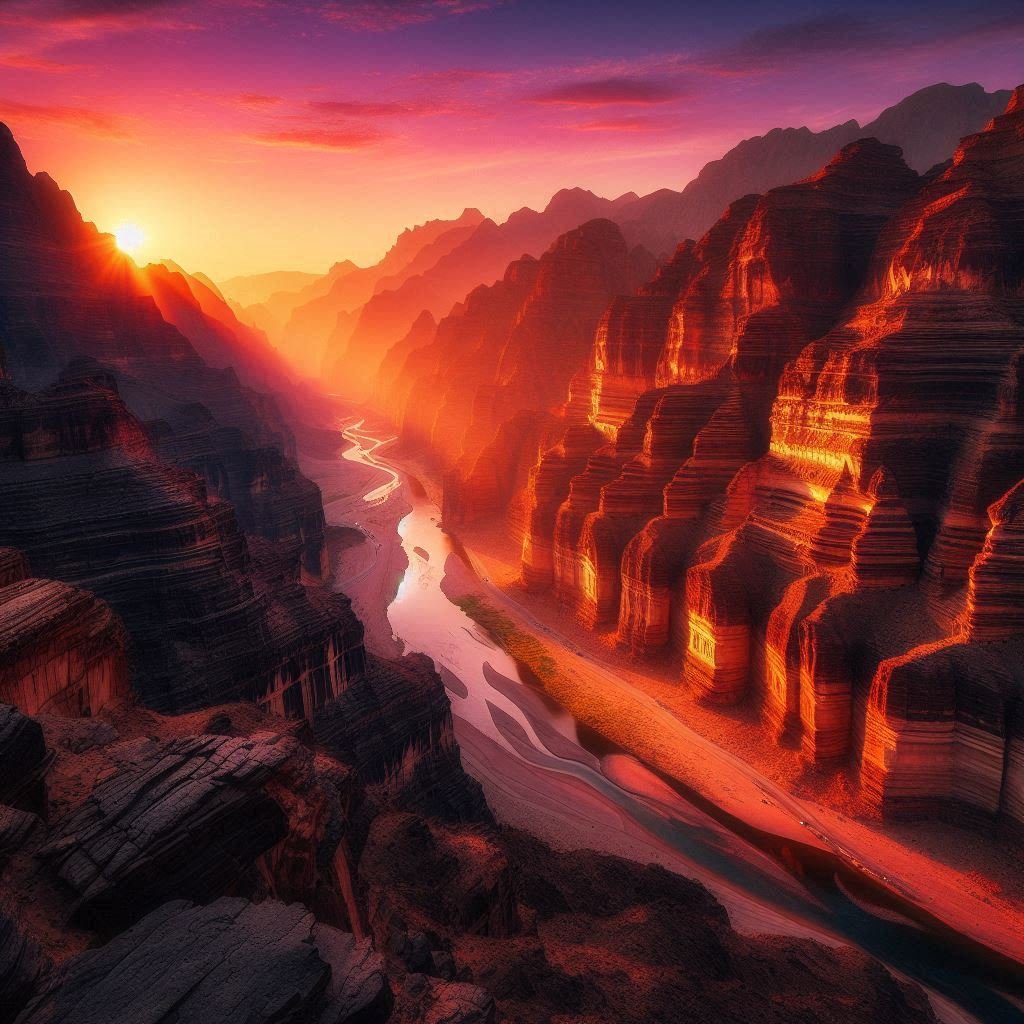Wadi Nakhr, the Grand Canyon of the East
Nestled within the rugged embrace of Oman’s Al Hajar Mountains lies Wadi Nakhr, a geological masterpiece that rivals the grandeur of the Colorado Plateau. Known as the Grand Canyon Oman, this awe-inspiring gorge plunges deep into the earth, its towering limestone cliffs painted in hues of amber and ochre by the relentless hands of time. A river snakes through its base, carving a path that whispers tales of millions of years of erosion and transformation!

Forget the Colorado Plateau, the Middle East holds its own geological marvel: the Grand Canyon Oman, Wadi Nakhr. Oman, a land of dramatic contrasts, is gaining recognition as a premier geo-tourism destination. From the towering peaks of the Al Hajar Mountains to the serene coastlines and the vast expanses of the Wahiba Sands desert, this country boasts a remarkable diversity of landscapes and geological wonders. Among these, Wadi Nakhr stands out as a prime example of Oman’s unique geology and breathtaking scenic beauty. Carved into the heart of the Al Hajar range, this majestic Grand Canyon Oman offers a breathtaking glimpse into Oman’s geological past and present.
Journey to the Heart of the Al Hajar Mountains
The Al Hajar Mountains, stretching across northern Oman, are a geological wonder and a defining feature of the region’s landscape. Rising dramatically from the surrounding plains, these mountains reach heights of over 3,000 meters, with Jebel Shams, standing as Oman’s highest peak at 3,009 meters. The Al Hajar Mountains are a testament to the immense tectonic forces that shaped the region. Millions of years ago, the collision of the Arabian and Eurasian tectonic plates thrust these mountains upward, exposing layers of rock that tell a story spanning hundreds of millions of years.

This same collision also set the stage for Grand Canyon Oman. Over vast periods, erosion thinks powerful wadi floods and the slow work of weathering carved out this deep gorge. Wadi Nakhr’s sheer size and the dramatic way it showcases the earth’s history have rightfully earned it the nickname Grand Canyon of the Middle East. It’s an apt description of this truly awe-inspiring natural wonder.
Exploring Wadi Nakhr: A Geological Wonderland
Grand Canyon Oman is a geological masterpiece. over a kilometer wide in places, plunging more than 1,000 meters deep, and stretching for 12 kilometers. That’s Wadi Nakhr. Its sheer scale is breathtaking, but it’s the details that truly captivate. Towering cliffs, sculpted by millennia of erosion, reveal layer upon layer of rock, a visual timeline of Earth’s history. How did this incredible Grand Canyon Oman form?
The real magic of Wadi Nakhr: Grand Canyon Oman lies in its exposed rock layers, a textbook example of the Hajar Supergroup. This sequence of limestone, formed in ancient seas, tells a story that spans millions of years. are like chapters in a geological history book, revealing clues about ancient environments, sea levels, and even the movement of continents.
Fossils of marine creatures, like corals and ammonites, are sometimes found within the rock layers, offering a tangible connection to the past. The colors and textures of the rock formations add another layer of wonder.
Wadi Nakhr, with its sheer cliffs and deep gorge, is a striking example of this geological legacy, earning it the nickname Grand Canyon of the Middle East. Like its North American counterpart, Grand Canyon Oman’s immense scale, and layered rock formations, create a striking mosaic of whites, grays, and earthy tones, while the interplay of light and shadow across the canyon’s walls adds to its dramatic appeal. The textures of the rock, from smooth, weathered surfaces to jagged outcrops, further enhance the canyon’s rugged beauty.
Oman’s Geological Exotics: Jebel Misht and Jebel Kawr
Oman’s geology is full of surprises, and one of the most intriguing is the existence of exotic rock formations that seem like they belong somewhere else entirely. as geological puzzles or pieces of ancient ocean islands that somehow ended up here. Jebel Misht and Jebel Kawr are two of the most stunning examples you’ll find:
- Jebel Misht is a real showstopper, with its bright white limestone cliffs that jut dramatically out of the surrounding landscape. Geologists believe it was once a bustling atoll in a long-gone ocean.
- Jebel Kawr is another impressive mountain, and it also has some unique features that make it stand out from the rocks around it.

Both of these mountains are made mostly of limestone, and if you look closely, you might find some amazing fossils of creatures that lived in those ancient seas things as corals, crinoids, and stromatolites. These fossils are like little time capsules, giving us a glimpse into life millions of years ago.
The story of how these exotics got to Oman is pretty incredible. It all comes down to the movement of Earth’s tectonic plates. As these plates shifted and bumped into each other, these ocean islands were pushed onto the edge of the continent. This process, called obduction, is how these “foreign” rocks became part of the Omani landscape. this is how Jebel Misht and Jebel Kawr add another layer of fascination to Oman’s already rich geological history, showing us just how powerful these tectonic forces can be and reminding us of the long-lost oceans that once covered this land.
The Balcony Walk: A Thrilling Adventure
the Balcony Walk in Grand Canyon Oman is an absolute must. This challenging but rewarding trail clings to the western rim of the Grand Canyon Oman, offering unparalleled perspectives of the geological wonderland below and the majestic peaks surrounding it. traversing a narrow path, carved into the cliff’s very edge, with the canyon floor plunging a thousand meters below. It’s an experience that will leave you breathless, both from the landscape’s exertion and sheer beauty. the vastness of the canyon and the silence of the mountains creating a profound sense of connection to nature.
The panoramic views of Wadi Nakhr are simply stunning: the layered rock formations in all their glory, the Grand Canyon Oman walls painted with vibrant hues, and the distant peaks of Jebel Shams and other mountains create a dramatic backdrop. Along the way, you might even encounter some of Oman’s unique wildlife. such as the nimble goats, as they navigate the rocky terrain in search of food. you might also spot the majestic Egyptian vulture soaring on thermals above the canyon.
As Sab: A Cliffside Village Frozen in Time
A highlight of the Balcony Walk is the abandoned village of As Sab, perched precariously on the cliffside. This once-thriving community, now a collection of crumbling stone houses, offers a testament to the resourcefulness of the people who once called this challenging environment home. Exploring the ruins of As Sab adds a layer of historical intrigue to an already unforgettable adventure in Grand Canyon Oman.
Planning Your Trip to the Grand Canyon of Oman
Ready to experience the Grand Canyon Oman for yourself? Most journeys begin in Muscat, Oman’s capital. From there, you can drive to Nizwa, a historic city and a great base for exploring the region. The charming village of Al Hamra is the gateway to Wadi Nakhr. unpaved roads demand sturdy transportation.
- Accommodation options range from guesthouses in nearby villages to more luxurious resorts further afield. While no specific permits are typically required for visiting Grand Canyon Oman itself, it’s always a good idea to check for any updates before you go.
- The best time to visit Grand Canyon Oman is during the cooler months, from October to April when temperatures are more pleasant for hiking and exploring. It is better to avoid the scorching summer months.
- Beyond Wadi Nakhr, the Al Hajar Mountains offer a wealth of opportunities for outdoor enthusiasts. Numerous hiking and trekking trails crisscross the region. including hiking Jebel Shams, exploring other wadis like Wadi Ghul and Wadi Bani Awf, and visiting historic forts and villages is a must.
- When visiting Oman, it’s important to be mindful of cultural sensitivities and local customs. do your part to promote responsible tourism and environmental awareness. Leave no trace, respect wildlife, and support local communities to ensure that this incredible natural wonder remains pristine for generations to come.
Grand Canyon Oman: Hiking, History, and Natural Beauty
Wadi Nakhr, the Grand Canyon Oman, stands as a testament to the Earth’s immense power and the beauty of natural erosion. From its dramatic cliffs and exposed rock layers showcasing the Hajar Supergroup to the fascinating “exotic” mountains like Jebel Misht and Jebel Kawr, this geological wonderland offers a unique geological masterpiece that offers a breathtaking journey through time. Carved into the Al Hajar Mountains, its rich fossil record reveals the dynamic forces that shaped Oman’s landscape over millions of years.
The thrilling yet rewarding Balcony Walk provides unparalleled views. This remarkable destination truly lives up to its “Grand Canyon” moniker, offering an unforgettable experience for nature lovers and geology enthusiasts alike. Its unique beauty and scientific significance make Grand Canyon Oman a must-visit destination.
So, what are you waiting for? Start planning your Grand Canyon Oman adventure today and witness the awe-inspiring grandeur of Wadi Nakhr for yourself!


